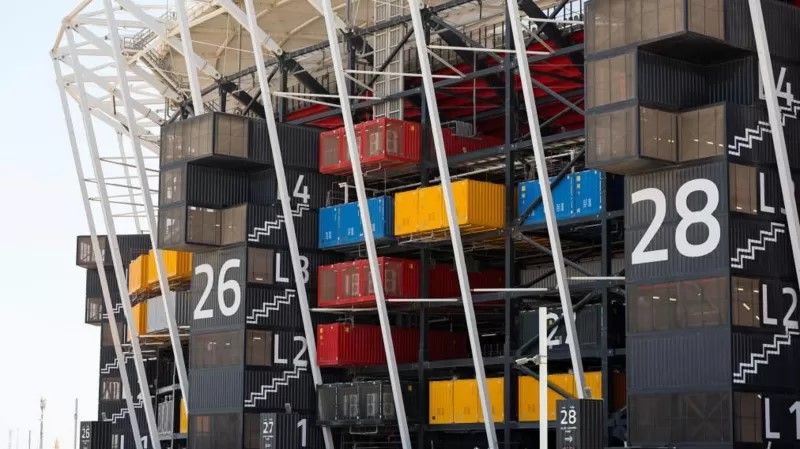The temporary Stadium 974 being built in Qatar for the FIFA World Cup 2022 hosted seven matches in two weeks and now the first temporary stadium for the World Cup will be demolished soon.
The stadium was named Stadium 974 after the international dialing code of Qatar and the number of shipping containers used in its construction. It was one of seven stadiums built for the World Cup.
The entire steel structure of Stadium 974 can be rebuilt as a venue of similar size or several smaller facilities for another World Cup or major sporting event.
Qatar described the stadium as a ‘beacon of sustainability as part of its commitment to deliver the first carbon-neutral World Cup.
As well as seven new stadiums, Qatar has built a new airport, metro system, roads, and nearly 100 new hotels, but the way it has treated the thousands of migrant workers working to build the infrastructure has raised eyebrows. Qatar had to face severe criticism for this.
Stadium 974 will be used for fashion shows and concerts in the coming days, while a spokesman for the Qatar 2022 organizing committee says there is as yet “no fixed timeline for its complete demolition and redevelopment”. not determined.
So how sustainable is the Stadium 974 project and when and where will the stadium be reused?

A glimpse of the future?
The 44,089-capacity stadium 974 is located on Doha’s waterfront and rests on a modular steel frame that resembles colorful shipping containers from the outside. It has the facility of washrooms as well as food stalls.
It was the only stadium built for the World Cup without air conditioning. Therefore, only evening matches were hosted here and the last match was played by Brazil against South Korea on 5 December to make it to the last 16.
The use of shipping containers and recycled steel helped reduce waste and construction time compared to other new locations.
Environmental watchdog group Carbon Market Watch said if existing reusable infrastructure could be reused, it could bid for major sporting events and make it ‘more accessible to developing countries. This will happen because the cost will be split between the many countries hosting the different editions.
A report on Stadium 974, which was commissioned by FIFA and provided by experts in reducing carbon emissions, also pointed to this advantage, saying that the stadium would thus be more centralized and ‘easily accessible. ‘ Will happen. Minimizing ‘intra’, locations can be accessed. -City Fan Travel’ during the tournament.
Organizers have also said that they will donate 170,000 seats from other stadiums to developing countries to make them more sustainable and prevent future use, but Carbon Market Watch said that the seats or they will be allocated for the seats. Couldn’t find a concrete plan’.
Environmentalists have also termed the claim of the Qatar World Cup being carbon neutral as ‘dangerous and misleading. They say the carbon footprint of the tournament could be three times higher than the stated levels.

The importance of reuse
The FIFA report compared the carbon emissions from the construction of Stadium 974 with the average emissions from four permanent stadiums with a capacity of 40,000–45,000.
It found that temporary stadiums emit more carbon than permanent stadiums that use mainly concrete ‘due to the use of carbon-intensive materials such as metal and steel initially’ but dismantled and reassembled several times can go.
So as it is currently built, the stadium has a higher carbon footprint than other permanent stadiums planned for Qatar 2022.
Carbon Market Watch says that the lower total carbon footprint of temporary stadiums than permanent stadiums “depends on how often and how far the stadium is moved and reconfigured.”
FIFA’s study examined three different scenarios for the future of Stadium 974, with it being reused once, twice, or thrice in a series of different venues.
It found that if the temporary stadium was reused only once, it would be ‘environmentally more beneficial than building two permanent stadiums ‘within a total sea and road travel distance of 7,033 km. He also highlighted the environmental benefits of rebuilding stadiums within the region or specifically in Qatar.
Thus the maximum travel figure increases to a total of 40,118 km for two-time use and 72,616 km for three-time use.
All three scenarios are built on the same temporary stadium, which will spend four years at the first location and then the same number of years at each location until it reaches its final destination of 60 years.

Where is the stadium going?
It appears that no decision has yet been made regarding the future use or location of Stadium 974.
Carbon Market Watch said that although organizers have highlighted the ‘temporary nature of the stadium collapse’, we have not been able to identify any specific plans that indicate the stadium will be destroyed if it is toppled. Will go Where will it be shifted?’
There are reports that Stadium 974 could be sent to Uruguay, which is set to be part of a joint bid for the 2030 World Cup with Argentina, Chile, and Paraguay.
Uruguay is about 13,000 km from Doha, so if the temporary stadium is moved there, it will have to be reused at a third location, which is more environmentally friendly than building new stadiums all over the place.
When asked about future plans for a possible venue for Stadium 974, the organizing committee said, “Qatar is on track to deliver the first carbon-neutral FIFA World Cup.”
“This means that all infrastructure projects, including the eight stadiums, must meet strict sustainability standards.”
‘Throughout their construction, we built from recycled materials wherever possible and implemented extensive energy and water-saving solutions. In addition, sustainably sourced materials were used and innovative heritage projects were implemented to ensure that the tournament did not become a white elephant.



